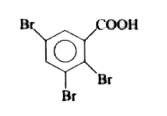The reaction of Br2/PorCl2/P with carboxylic acid to form α- halogenated acid, is called
Hunsdicker reaction
Hell - Vohlard - Zelinsky reaction
Claisen reaction
Kolbe's reaction
The correct Answer is:B
To solve the question regarding the reaction of bromine or chlorine with carboxylic acids to form alpha-halogenated acids, we can follow these steps:
1. Identify the Reactants: The reactants in this reaction are carboxylic acids (e.g., acetic acid, CH₃COOH) and halogens (bromine, Br₂ or chlorine, Cl₂) in the presence of phosphorus (P).
2. Understand the Reaction Mechanism: When a carboxylic acid reacts with a halogen in the presence of phosphorus, the halogen replaces one of the hydrogen atoms on the alpha carbon (the carbon adjacent to the carboxyl group).
3. Example of the Reaction: For instance, if acetic acid (CH₃COOH) reacts with bromine (Br₂) in the presence of red phosphorus (P), the reaction will yield 2-bromoacetic acid (CH₂BrCOOH). The bromine replaces one of the hydrogen atoms on the alpha carbon.
4. Naming the Reaction: This specific reaction is known as the Hell-Volhard-Zelinsky reaction. It is a halogenation reaction that introduces a halogen atom at the alpha position of the carboxylic acid.
5. Select the Correct Option: Given the options, the correct name for the reaction is the Hell-Volhard-Zelinsky reaction.
Final Answer:
The reaction of Br₂ or Cl₂ with carboxylic acid to form alpha-halogenated acid is called the Hell-Volhard-Zelinsky reaction.
---
The reaction of Br₂ or Cl₂ with carboxylic acid to form alpha-halogenated acid is called the Hell-Volhard-Zelinsky reaction.
Similar Questions
Knowledge Check
The action of Br2/H2O on salicylic acid results in the formation of :
A B
B C
C D
D
Carboxylic acids contain carbonyl group but do not show the nucleophilic addition reaction like aldehydes or ketones. Whey?
View SolutionCarboxylic acids contain carbonyl group but do not show the nucleophilic addition reaction like aldehydes or ketones. Whey?
View SolutionCarboxylic acids contain carbonyl group but do not show the nucleophilic addition reaction like aldehydes or ketones. Whey?
View SolutionWhy are carboxylic acids called fatty acids?
View SolutionWhy are carboxylic acids called fatty acids?
View SolutionWhy are carboxylic acids called fatty acids?
View SolutionPropene on reaction with Br2inCCl4 yields
View Solution